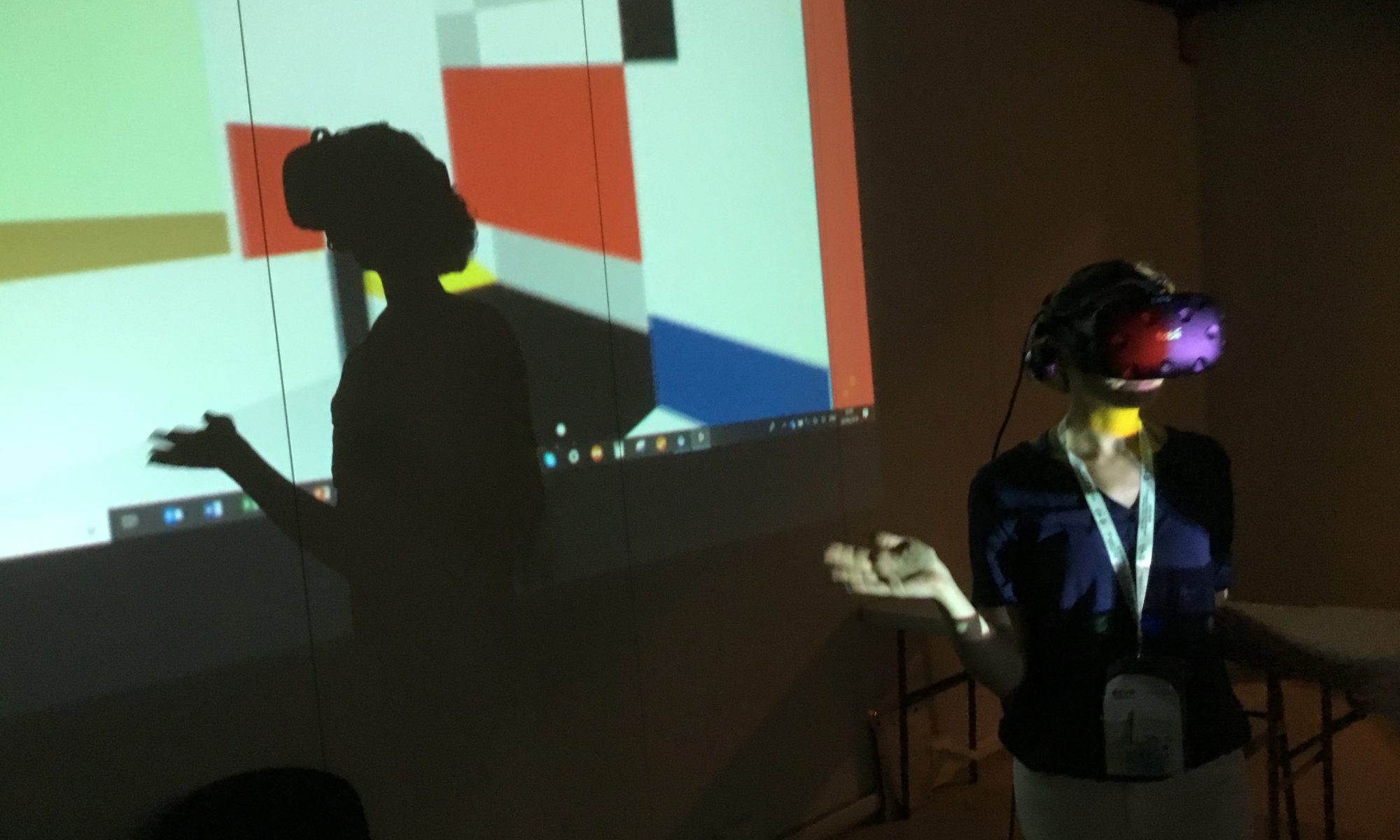Spatial Vision: Sciences and Arts – visualising of Mondrian’s interior design
Piet Mondrian’s dogmatic proclamations (Mondrian, 1920) to use exclusively cardinal lines are challenged when his patterns are placed in a 3D context. The only viable solution is where observer’s viewpoint is restricted to a frontoparallel inspection. In a cubic room, however, the observer is allowed to look from a wide range of viewpoints and non-cardinal orientations become obvious. To visualise this, we created a 3D model of the ‘Salon’ and removed the wall closest to the observer to render an inside look for any given viewpoint.

Ambiguity of converging lines in 3D: without oblique converging lines suggesting perspective planes, a trapezoid can be seen both as trapezoid in the frontoparallel plane and as a slanted rectangle belonging to another perspective plane. (Image adapted from Kitaoka, 2014)
Mondrian’s original drawings for the ‘Salon’ show pattern of rectangles filled with primary colours, and lines that are largely reduced to boundaries between rectangles. We visualised our 3D model as Computer Graphics (CG) ‘Salon’, without rectangle outlines and another variant with heavy black lines, truer to his iconic style (Stevanov & Zanker, 2017). The ‘Salon’ with prominent cardinal lines demonstrates that oblique converging lines are very strong cues to depth perception and facilitate the shape constancy i.e. patterns on the side walls are seen as slanted rectangles rather than a trapezoid on a frontoparallel plane. Distortions of rectangular shapes and non-cardinal orientations are best seen in the static retinal image of vertexes of the ‘Salon’. A pattern of thick black lines would facilitate shape constancy of rectangles from a range of vantage points; whereas distortions of rectangles in vertexes are more pronounced without thick black lines, as they are more likely to be interpreted both as trapezoids and rectangles.

These unwanted distortions of rectangular shapes could be reduced in a room without corners; in a hypothetical cylindrical room. We created a CG model of a cylindrical Mondrian-like room with the same overall dimensions as the ‘Salon’. The four walls of the Mondrian’s ‘Salon’ were mounted on the circular wall next to each other. With half of the cylinder being in the field of vision, horizontal lines only appear horizontal in the centre, but bend upwards and downwards in the periphery deviating from orthogonality. The sense of a rectilinear composition could be enhanced by restricting the field of vision, for instance by getting closer to the wall ahead. The peripheral distortions retain the conflict with Mondrian’s ideal, which is further enhanced by more prominent black lines.

Whilst the cylindrical space provides a partial work-around, it would remain far from a universal guidance for neoplastic architecture. Mondrian strictly believed that universal beauty could be defined solely by properties of objects. In that sense, a Mondrian-type space may just not be beautiful as it falls short of strict Neoplastic ideals of beauty. However, a century later, converging evidence from both vision science and empirical aesthetics suggests that aesthetic judgement arises from the interaction between object features, properties of our visual system, and processes of value attribution (Huston et al. 2015). Therefore we propose a simple solution: aesthetic judgement should be based on our perceptual representation rather than static retinal images- after all, the beauty is not in the eye, but in the mind of the beholder.
References
Huston, J. P., Nadal, M., Mora, F., Agnati, L. F., & Cela Conde, C. J. (2015). Art, aesthetics, and the brain. Oxford, United Kingdom: Oxford University Press.
Kitaoka, A. (2014, September 18). Ambiguous or reversible figures. Retrieved March 21, 2017, from http://www.psy.ritsumei.ac.jp/~akitaoka/tagi7e.html
Stevanov, Jasmina, & Zanker, Johannes M. (2017). Exploring Mondrian Compositions in Three-dimensional Space. Leonardo, 1-11. doi:10.1162/LEON_a_01583
